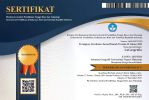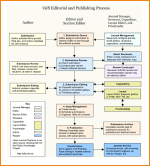Kajian Kapasitas Masyarakat Berbasis Aset Penghidupan Terhadap Bencana Kekeringan
(1) Program Studi Ilmu Lingkungan, Universitas Negeri Semarang
(2) Ilmu Lingkungan, Sekolah Pascasarjana, Universitas Diponegoro
(3) Sekolah Ilmu Lingkungan, Universitas Indonesia
(4) Program Studi Pendidikan Geografi, Universitas Negeri Semarang
(5) Program Studi Pendidikan Ilmu Pengetahuan Sosial, Universitas Negeri Semarang
(6) Program Studi Pendidikan Ilmu Pengetahuan Sosial, Universitas Negeri Semarang
(7) Program Studi Pendidikan Ilmu Pengetahuan Sosial, Universitas Negeri Semarang
(*) Corresponding Author
DOI: https://doi.org/10.35580/lageografia.v21i1.37174
Abstract
Abstract
Windurojo Village in Kesesi District, Pekalongan Regency is one of the areas with the most susceptible to drought. Therefore, this study aims to assess community capacity against drought in Windurojo Village at the household level and to analyze the relationship between variables. This study used a livelihood asset approach with data collection focused on Serang Hamlet, which is the area with the worst drought. The results of the study stated that the livelihood asset with the highest scale in Serang Hamlet was human capital. The results of the crosstab analysis also show that human capital is related to other capital, but the Spearman correlation results show that the highest relationship is found in financial and physical capital. The scoring results show that the capacity of the community against drought in Serang Hamlet is mostly medium class capacity, only 5 families are of high class capacity.
Abstrak
Desa Windurojo di Kecamatan Kesesi, Kabupaten Pekalongan merupakan salah satu daerah yang paling rawan terhadap kekeringan. Oleh karena itu, penelitian ini bertujuan untuk menilai kapasitas masyarakat terhadap kekeringan di Desa Windurojo pada tingkat rumah tangga dan menganalisis hubungan antar variabelnya. Penelitian ini menggunakan pendekatan aset penghidupan dengan pendataan terfokus pada Dusun Serang yang merupakan daerah dengan kekeringan terparah. Hasil penelitian menyebutkan bahwa aset penghidupan dengan skala tertinggi di Dusun Serang adalah modal manusia. Hasil analisis crosstab juga menunjukkan bahwa modal manusia berhubungan dengan modal lainnya, namun hasil korelasi Spearman menunjukkan hubungan tertinggi terdapat pada modal fisik dan finansial. Hasil skoring menunjukkan bahwa daya tampung masyarakat terhadap kekeringan di Dusun Serang sebagian besar kelas menengah dan hanya 5 kepala keluarga yang kelas tinggi.
Keywords
Full Text:
PDFReferences
Abdurrahim, A. Y., Dharmawan, A. H., Sunito, S., & Sudiana, I. M. (2014). Kerentanan ekologi dan strategi penghidupan pertanian masyarakat desa persawahan tadah hujan di pantura Indramayu. Jurnal Kependudukan Indonesia, 9(1), 133-152.
Adhikari, S. (2018). Drought impact and adaptation strategies in the mid-hill farming system of western Nepal. Environments, 5(9). https://doi.org/10.3390/environments5090101
Amanda, L., Yanuar, F., & Devianto, D. (2019). Uji Validitas dan Reliabilitas Tingkat Partisipasi Politik Masyarakat Kota Padang. Jurnal Matematika UNAND, 8(1), 179-188. https://doi.org/10.25077/jmu.8.1.179-188.2019
Ananto Aji, Wahid Akhsin Budi Nur Sidiq, Satya Budi Nugraha, Dewi Liesnoor Setyowati, N. K. T. M. (2016). Risiko Bencana Di Kabupaten Pekalongan (Disaster Risk in Pekalongan Regency). Jurnal Geografi : Media Informasi Pengembangan Dan Profesi Kegeografian, 13(2), 179-190.
Bailey, K. M., McCleery, R. A., & Barnes, G. (2019). The role of capital in drought adaptation among rural communities in Eswatini. Ecology and Society, 24, 3. https://doi.org/10.5751/ES-10981-240308
Baiquni, M. (2006). Pengelolaan sumber daya perdesaan dan strategi penghidupan rumah tangga di Provinsi Daerah Istimewa Yogyakarta pada masa krisis (1998-2003). Yogyakarta.
BNPB. (2012). Regulation No. 2-2012.
Brown, P. R., Afroz, S., Chialue, L., Chiranjeevi, T., El, S., Gr"unb"uhel, C. M., Khan, I., Pitkin, C., Reddy, V. R., Roth, C. H., Sacklokham, S., & Williams, L. J. (2019). Constraints to the capacity of smallholder farming households to adapt to climate change in South and Southeast Asia. Climate and Development, 11(5), 383-400. https://doi.org/10.1080/17565529.2018.1442798
Carver, C. S., Scheier, M. F., & Weintraub, J. K. (1989). Assessing coping strategies: a theoretically based approach. Journal of Personality and Social Psychology, 56(2), 267. https://doi.org/10.1037/0022-3514.56.2.267
De Silva, M. M. G. T., & Kawasaki, A. (2018). Socioeconomic vulnerability to disaster risk: a case study of flood and drought impact in a rural Sri Lankan community. Ecological Economics, 152. https://doi.org/10.1016/j.ecolecon.2018.05.010
DFID. (2002). Sustainable Urbanisation: Achieving Agenda 21. Un-Habitat, 1792(August), 20. https://doi.org/10.3141/1792-02
Gaillard, J. C. (2010). Vulnerability, capacity and resilience: Perspectives for climate and development policy. Journal of International Development, 467(7318), 912-913.
Hadiyan, M. (2018). Ini Solusi dari BPBD untuk Atasi Kekeringan di Desa Windurojo. Diakses Dari Radarpekalongan.Co.Id Pada, 23.
Hendrayana, H., & Ramadhika, R. (2016). Penentuan Zona Konservasi Cekungan Air Tanah Wates, Kabupaten Kulon Progo, Daerah Istimewa Yogyakarta. Proceeding Seminar Nasional Kebumian Ke-9, 2010.
Heriyanti, A. P., Purwanto, P., Purnaweni, H., & Fariz, T. R. (2022). Greenhouse Gas Emissions and Biogas Potential From Livestock in Rural Indonesia. Jurnal Pendidikan IPA Indonesia, 11(1), 35-46. https://doi.org/10.15294/jpii.v11i1.34465
Hidayati, D. (2012). Coping Strategy Pada Kondisi Darurat Bencana: Pembelajaran Dari Masyarakat Bantul Menghadapi Gempa. Jurnal Kependudukan Indonesia, 7(1), 75-92.
Husna, N. (2014). Kekerasan Terhadap Perempuan Sebagai Pekerja Migran. Jurnal Al-Bayan., 21, 30.
Huynh, L. T. M., & Stringer, L. C. (2017. (2018). Multi-scale assessment of social vulnerability to climate change: An empirical study in coastal Vietnam. Journal Climate Risk Managment, 20, 165-180. https://doi.org/10.1016/j.crm.2018.02.003
Irungu, M., Muriithi, J., & Njue, J. (2021). Outcomes Of Livelihood Diversification Among Agro-Pastoral Households In Laikipia County, Kenya. Journal of Poverty, Investment and Development, 6(1). https://doi.org/10.47604/jpid.1422
Istikomah, I. (2013). Pengaruh Program Sertifikasi Tanah Terhadap Akses Permodalan Bagi Usaha Mikro Dan Kecil Studi Kasus Program Sertifikasi Tahun 2008 Di Kabupaten Kulon Progo. Jurnal Kawistara, 3, 1. https://doi.org/10.22146/kawistara.3959
Jamshed, A., Rana, I. A., Mirza, U. M., & Birkmann, J. (2019). Assessing relationship between vulnerability and capacity: An empirical study on rural flooding in Pakistan. International Journal of Disaster Risk Reduction, 36(10110), 9. https://doi.org/10.1016/j.ijdrr.2019.101109
Johar, M., Soewondo, P., Pujisubekti, R., Satrio, H. K., Adji, A., & Wibisono, I. D. (2019). Tahukah kamu? : : Analisis Set Data Survei Sosial Ekonomi Nasional (Susenas). Jurnal Ekonomi Dan Pembangunan Indonesia, 19(2), 191-208. https://doi.org/10.21002/jepi.v19i2.843
Keshavarz, M., Maleksaeidi, M., & Karami, E. (2016). Livelihood vulnerability to drought: A case of rural Iran. International Journal of Disaster Risk Reduction, 21(2017), 223-230. https://doi.org/10.1016/j.ijdrr.2016.12.012
Lizuka, A. (2020). Developing Capacity for Disaster Risk Reduction: Lessons Learned From a Case of Sri Lanka. Progress in Disaster Science, 6. https://doi.org/10.1016/j.pdisas.2020.100073
Mainali, J., & Pricope, N. G. (2019). Mapping the need for adaptation: assessing drought vulnerability using the livelihood vulnerability index approach in a mid-hill region of Nepal. Climate and Development, 11(7), 607-622. https://doi.org/10.1080/17565529.2018.1521329
Nugraha, F. A. (2020). Kapasitas masyarakat Desa Windurejo, Kecamatan Kesesi, Kabupaten Pekalongan terhadap kesiapsiagaan menghadapi bencana kekeringan. Universitas Diponegoro.
Nugraha, F. A., & Maryono, M. (2020). Kajian Kapasitas Masyarakat terhadap Bencana Kekeringan di Desa Windurojo Kabupaten Pekalongan. Prosiding Seminar Nasional Lahan Suboptimal Ke-, 8, 314-324.
Rahmi, M., Setiawan, M. A., & Mardiatno, D. (2019). Analisis Kekeringan Berdasarkan Bentuklahan Di DAS Bompon. Media Komunikasi Geografi, 20(2), 90-100. https://doi.org/10.23887/mkg.v20i2.18399
Rijal, A. S., Matalapu, I., Jaya, R., & Maulana, K. M. (2021). Analisis Mitigasi Bencana terhadap Kondisi Sosial Budaya di Gorontalo. LaGeografia, 19(2), 155-174. https://doi.org/10.35580/lageografia.v19i2.17221
Rusdi. (2014). Remitansi TKI dan Dampaknya Terhadap Pengentasan Kemiskinan Daerah Asal, di Kabupaten Malang. Seminar Nasional Riset Inovatif., 2.
Sudaryanto. (2016). Drought Vulnerability Mapping With Geomorphological Approach in Yogyakarta Special Region (DIY) and Central Java. Earth and Enviromental Science. https://doi.org/10.1088/1755-1315/47/1/012023
Supriatna, A. (2008). Aksesibilitas petani kecil pada sumber kredit pertanian di tingkat desa: Studi kasus petani padi di Nusa Tenggara Barat. Jurnal Sosial Ekonomi Pertanian.
Susanto, B. (2018). Warga Desa Windurojo, Kabupaten Pekalongan, Harus Antre Berjam-jam Untuk Dapatkan Air Bersih. Diakses Dari Tribunjateng.Com Pada, 23.
Thao, N. T. T., Khoi, D. N., Xuan, T. T., & Tychon, B. (2019). Assessment of livelihood vulnerability to drought: A case study in Dak Nong Province, Vietnam. International Journal of Disaster Risk Science, 10(4), 604-615. https://doi.org/10.1007/s13753-019-00230-4
Thathsarani, U. S., & Gunaratne, L. H. P. (2018). Constructing and index to measure the adaptive capacity to climate change in Sri Lanka. Procedia Engineering, 212, 278-285. https://doi.org/10.1016/j.proeng.2018.01.036
Widodo, N. (2009). Permasalahan Tenaga Kerja Indonesia di Daerah Asal, Studi Kasus Kabupaten Tulungagung Jawa Timur. Jurnal Penelitian Dan Pengembangan Kesejahteraan Sosial, 14, 33-46.
Wijayanti, R., Baiquni, M., & Harini, R. (2016). Strategi penghidupan berkelanjutan masyarakat berbasis aset di Sub DAS Pusur, DAS Bengawan Solo. Jurnal Wilayah Dan Lingkungan, 4(2), 133-152. https://doi.org/10.14710/jwl.4.2.133-152
Zhao, Y., Fan, J., Liang, B., & Zhang, L. (2019). Evaluation of sustainable livelihoods in the context of disaster vulnerability: A case study of Shenzha county in Tibet, China. Sustainability, 11(10), 2874. https://doi.org/10.3390/su11102874
Article Metrics
Abstract view : 333 times | PDF view : 263 timesRefbacks
- There are currently no refbacks.
Copyright (c) 2022 Trida Ridho Fariz, Fajar Adie Nugraha, Gede Aswin Yoga Putra, Ananto Aryo Nugroho, Dyah Ratna Salima, Lestarina Estifani Pradiny, Ahmad Faesal Mubarizi

This work is licensed under a Creative Commons Attribution-NonCommercial 4.0 International License.
LaGeografia: Jurnal Program Studi Pendidikan Geografi, Jurusan Geografi, Fakultas MIPA, Universitas Negeri Makassar.
Email: lageografia@unm.ac.id | +6285298749260
Editorial Office














































